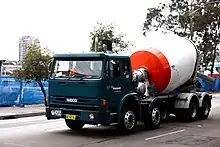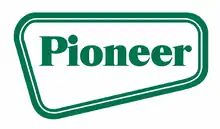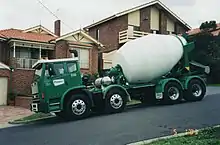Hanson Australia
Hanson Australia is a premixed concrete, aggregates and precast company. Founded in 1949 as Pioneer Concrete and later re-branded to Pioneer International, it was taken over by Hanson in 1999.

 | |
| Type | Limited company |
|---|---|
| Industry | Construction |
| Founded | 1949 as Pioneer Concrete |
| Founder | Tristan Antico Kelvin Conley |
| Headquarters | , |
Key people | Phil Schacht (CEO) |
| Products | Building Materials |
| Services | Ready-mix concrete |
| Owner | Hanson |
| Subsidiaries | Hymix Concrete Pioneer North Queensland Hanson Precast Cement Australia Pioneer Concrete Hanson Australia Cement. |
| Website | www.hanson.com.au |
History
In 1949, Tristan Antico and Kelvin Conley formed Pioneer Concrete in New South Wales. In 1954 a concrete plant was acquired in Canberra. In 1959 it was listed on the Sydney Stock Market as a public company. As well as acquiring further concreting businesses, it diversified into building materials products.[1]
In 1961, Pioneer purchased a pre-mix concrete plant in Hong Kong. In 1962, it commenced operations in the United Kingdom, followed in 1963 by Israel and 1964 by Italy. In 1965, it formed a joint venture with Shell Australia to enter the asphalt manufacture and supply industry. In the same year, the company diversified into aggregate quarrying in Hong Kong. In 1967, Pioneer acquired FW Williams Holdings that had plastic manufacturing operations and tea and coffee plantations in Papua New Guinea.[1][2]

In 1970, Pioneer acquired pre-mix and quarrying companies in Spain and by the middle of the decade the company's interests had spread to Asia, Africa, and most of Europe. In 1973, in partnership with CSR Limited, Pioneer acquired Australian & Kandos Cement Holdings.[1]
In 1975, Pioneer diversified to invest heavily in resources in a joint project with Pennzoil. In 1978, Pioneer became involved in a major coal coking and steaming development in the Hunter Valley area of New South Wales in a joint venture with the Electricity Commission of New South Wales and Ampol. In 1979, Pioneer acquired a 20% stake in Ampol, which was increased to 65% in 1980. Ampol and Pioneer made further mineral acquisitions with uranium producers Nabarlek Uranium Mine and Queensland Mines.[1]
In 1983, Pioneer purchased British building materials producer Mixconcrete followed in 1985 by Lone Star Industries' sand, gravel, and quarrying operations in the United States. In 1986 Pioneer was the subject of a hostile but ultimately unsuccessful takeover bid from FAI Insurance.[3] In 1986, the building materials divisions in Italy, Portugal, and South Africa were sold. In 1987, mineral and gold producer Giant Resources was acquired. In 1988, the company changed its name to Pioneer International and gained full control of Ampol.[1][4]

In 1995, Ampol merged with Caltex to form Australian Petroleum Pty Ltd, with Pioneer holding a 50% shareholding, this was sold in 1998.[4][5] In 1998, Hymix Concrete was purchased.[6] In 1999, Pioneer International was taken over by Hanson.[7][8][9] It was rebranded as Hanson Australia in 2004.[10][11]
As of 2018, Hanson operated 226 ready mix concrete plants and 75 aggregate operations.[12]
References
- International Directory of Company Histories. St James Press. 1991.
- Pioneer Concrete lifts bid for FW Williams Canberra Times 8 October 1966 page 14
- FAI price to rise: Adler Canberra Times 7 October 1987 page 28
- History Ampol Singapore
- $3bn oil merger full steam ahead Canberra Times 29 March 1995 page 27
- Dennis O'Neil's Addenbrooke is back with a Pyrmont residential project Property Observer 23 November 2017
- ^ Hanson Proposes $2.5 Billion Acquisition of Pioneer Los Angeles Times 29 November 1999
- On aggregate, Hanson is a buy The Guardian 10 December 1999
- Pioneer International Limited Delisted Australia
- Rebranding of Pioneer to Hanson The Right Group
- Hanson completes rebranding exercise Inside Construction 4 June 2004
- Australia Heidelberg Cement